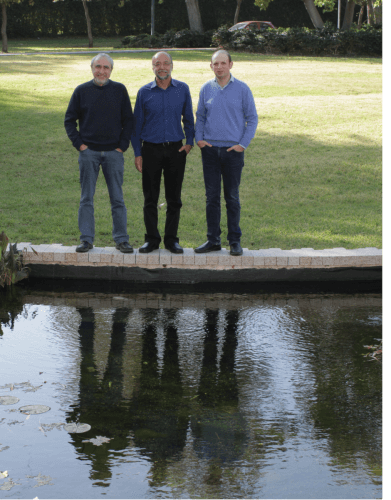Researchers from the Weizmann Institute were able to observe for the first time the creation of an excitonic liquid

From the right: Dr. Michael Stern, Prof. Israel Bar-Yosef and Dr. Vladimir Umansky. A lost entity. Photo: Weizmann Institute magazine
When we lose something, the lost entity is still in some way in our memory. In a sense, this memory gives the lost being a kind of deprived existence. This phenomenon is well known in the world of psychology and in the field of physiology ("phantom sensation"), but in fact it also takes place in the material world. Thus, for example, when electrons present in a semiconductor material "jump" to a higher energy level (as a result of optical excitation), they leave behind an electron deficiency, a type of "vacuity" or "hole". This "hole" acts and behaves as a material entity for everything and carries a positive electric charge, which is the opposite of the negative electric charge of the electron. In certain situations, the electron that jumped to a high energy level may move around the "hole" that it itself left behind. The "hole", which has the positive electrical charge, functions as a kind of nucleus for the atom called "exciton". But unlike atoms in nature - the excitons only exist for the blink of an eye. The excited electron strives to "return home", and to take its former place, instead of the "hole". Indeed, naturally, it manages to return to its original place in a very short time, usually a few nanoseconds. The light emitted in the process of returning the electron to its place is used as a tool to understand the lifestyles of the excitons, which are a fertile ground for research and many applications.
If the exciton is compared to an atom, the question arises: is it possible to create more complex structures, in which many excitons participate, for example, a crystal or a liquid of excitons?
Prof. Israel Bar-Yosef, from the Department of Condensed Matter Physics, together with Dr. Michael Stern and Dr. Vladimir Umansky, faced this challenge. The three were able to observe for the first time the creation of an excitonic liquid, and the results of this research were recently published in the scientific journal Science. The initial difficulty, which usually prevents the creation of complex structures of this type, is the short lifetime of the excitons. They disappear very soon after their formation, in fact immediately after, so it is impossible to create a high density of excitons, which is necessary to create a liquid. To extend the lifetime of the exciton and preserve it for a longer time, the researchers used multilayer structures built of thin layers, each a few tens of atoms thick.
Growing structures of this type is one of the areas of specialization of the Submicron Center at the Weizmann Institute of Science. With this method it is possible to create a "quantum well", which contains the electrons (and "holes") in a thin layer. When you create a structure of two quantum wells very close to each other and apply an electric field to it, you can cause the electron to be in one layer, and the "hole" - in the adjacent layer. In this state, the two still feel their mutual electric attraction, and are able to create an exciton, but their union is more difficult, since they are separated in space. This is how the scientists were able to create excitons whose existence time is very long, when the strength of the electric field that is applied to the system (and affects the distance between the electron and the "hole") is used as a tool to control this time.
Upon cooling the system to a low temperature and increasing the density of the excitons, the researchers observed a sharp transition (occurring at a temperature and density lower than the critical ones), in which the system is divided into two regions: a "gaseous" region, in which the excitons move randomly relative to each other, and a "liquid" region - in which their movement organized. The liquid observed in the laboratory is different from the liquids known in nature. Normally, crystals and liquids are formed as a result of the existence of attractive forces acting between atoms at close distances, but here the situation is reversed: the excitons repel each other, since the repulsive forces between electron and electron and between hole and hole (which are in the same layer) are slightly greater than the attractive forces acting between electrons and holes (found in different layers). The weak residual repulsion means that the excitons are positioned at equal distances - approximately - from each other, and together form an ordered dynamic structure, similar to a liquid state of aggregation.

One response
wow It's like a polka dance of phantom legs...